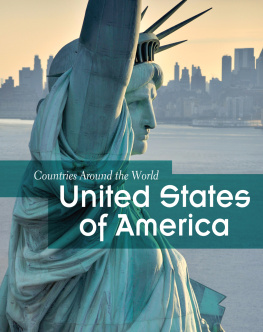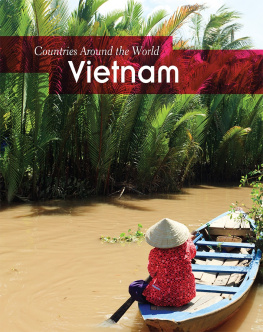Some words in the book are in bold, like this . You can find out what they mean bylooking in the glossary.
Introducing the United States of America
What comes to mind when you think of the United States of America? Do you see theU.S. flag, with its stars and stripes? Do you think of big cities with towering skyscrapers,or dramatic landscapes like the Grand Canyon? Or maybe movie stars or sports stars?
North America
The United States is an enormous and varied country. Its stunning scenery includesdramatic coastlines, mountain ranges, forests, deserts, rivers, and lakes. The UnitedStates is part of the continent of North America, which also includes Canada andMexico. After Canada, the United States is the second-largest country on the continent.It has an area of more than 3,794,100 square miles (9,826,675 square kilometers).The population of the United States is approximately 307 million, making it the thirdmost populated country in the world. The culture of the country shows great diversity ,with people from all around the world settling there.
Superpower
The United States is often referred to as a superpower. This refers to the strengthof its government and its influence over the rest of the world. In terms of size,population, and economy , the United States has been a very powerful country for overa century. The United States is often at the forefront of international efforts,whether in response to a natural disaster such as an earthquake or to the outbreakof war between two countries. This influence on a global scale creates both positiveand negative feelings toward the country.
Many U.S. cities have amazing skylines full of tall buildings.
History: Exploration, Colonization, and Conflict
Humans have lived in the land that is now the United States for more than 12,000years. Over time these people settled all over what is now North America. These people,who later became known as American Indians, or Native Americans, lived here for thousandsof years before other settlers arrived on the continent .
Daily life
American Indians made tools and hunted for food. Coastal people lived on a diet ofmainly fish, while inland tribes hunted animals such as bison (buffalo) for meat.Different tribes developed their own religions and cultures.
Discovering a new world
From the 1400s, explorers, including Christopher Columbus, set off from Europe. Theyexplored new lands in the Caribbean and the coasts of Central and South America.In 1497 John Cabot, an Italian navigator sailing on a British ship, became the firstEuropean to visit the northeast coast of North America since the Vikings in 1000CE.
Colonization
The first permanent British settlement in North America was Jamestown, which wasfounded in 1607 in present-day Virginia. Between 1620 and 1630 more colonists arrivedon the northeastern coast. The British people who migrated here were known as Puritans.They wanted to come to this new land because they thought that they would be freeto practice their religion in their own way.
The early colonists faced many hardships and dangers. Food was often scarce and diseasewas common. They also came into conflict with American Indian people. The AmericanIndians helped and supported the colonistsuntil their lands and way of life becamethreatened. Eventually, the colonists managed to establish farms and plantations.
This is an artist's impression of an early British settlement on the east coast ofNorth America.
The Declaration of Independence was adopted on July 4, 1776.
The American Revolution
The new settlers built up thriving settlements, and they began to resent the restrictionsimposed on their freedom by the British. On April 19, 1775, the Revolutionary Warbegan between the Americans and the British. In 1783 the Americans finally defeatedthe British.
Territorial expansion
In 1803 the United States bought land from the French in the Louisiana Purchase.For about $15 million, the United States acquired land that went from New Orleansin the south to Montana in the north. This encouraged more American citizens to movewestward.
War broke out between the United States and Mexico in 1846 over land ownership andboundaries. U.S. forces invaded Mexico and eventually gained lands that includedpresent-day New Mexico and California. The United States now controlled land fromthe east coast to the west coast.
Civil War (18611865)
From the 1500s, many Africans were taken from their homes and forced to work in thegrowing European settlements in North America. By the 1800s, slavery was a part oflife in the United States, and it became a major factor in the most devastating warin U.S. history.
The Civil War ripped the nation in half. The southern Confederate states fought toprotect slavery and break away from the northern states. The northern Union stateswanted to preserve the union and end slavery. This terrible war divided the country,and families and friends fought on opposite sides. More than 620,000 soldiers werekilled.
HARRIET TUBMAN (ABOUT 1820-1913)
Harriet Tubman was an escaped slave. She helped many other slavestoescapeto freedom in the North and Canada. During the Civil War, she served asanurseand spy for the Union Army.
Boom time
There were huge developments in industry after the Civil War. An increase in machine-operatedmanufacturing was driven by new inventions and railroad networks. The industrialgrowth caused a boom in the economy that continued into the 1900s.
World War I
The United States stayed out of World War I (191418) at first, but President WoodrowWilson and the American people were moved to join the war against Germany in 1917.Around two million soldiers were sent across the Atlantic to help the Allies to victoryin 1918.
The 1920s and the Great Depression
The 1920s are often known as the Roaring Twenties because of the booming economyand fast-paced life Americans experienced at that time. But by the end of the 1920s,the spectacular economic growth had become unstable, and in 1929 the stock market crashed.
During the Great Depression in the 1930s, people were forced to line up for hoursto get food.
During the Great Depression, which followed this crash, banks failed, millions ofworkers lost their jobs, and thousands of farmers were forced to abandon their farms.In 1933 around 13 million Americans were out of work.




















